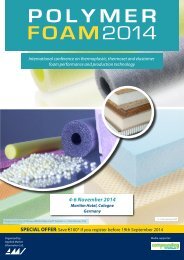Dissertations in Forestry and Natural Sciences
24lYKFN
24lYKFN
Create successful ePaper yourself
Turn your PDF publications into a flip-book with our unique Google optimized e-Paper software.
Characterization of wood-plastic composites<br />
The measurements are conducted under controlled<br />
conditions as def<strong>in</strong>ed <strong>in</strong> the st<strong>and</strong>ard. This states that the<br />
products should be tested at a temperature of 23 ± 2 °C <strong>and</strong> RH<br />
of 50 ± 5%, with an air velocity <strong>in</strong> the range 0.1–0.3 m/s. In<br />
addition, the temperature should not vary by more than ± 1.0 °C<br />
dur<strong>in</strong>g the measurements, <strong>and</strong> RH <strong>and</strong> air flow rate can<br />
fluctuate by only ± 3%. Before the measurements, the test<br />
chamber must be cleaned with alkal<strong>in</strong>e detergents <strong>and</strong> then<br />
r<strong>in</strong>sed twice with distilled water. In addition, clean<strong>in</strong>g by<br />
thermal desorption is also allowed. To elim<strong>in</strong>ate the possible<br />
effects of background emissions, an air sample of the empty<br />
emission chamber is taken before the actual measurements.<br />
When the sample is placed <strong>in</strong> the chamber, it should be<br />
positioned <strong>in</strong> the center of the chamber to ensure that the air<br />
flow is evenly distributed over the emitt<strong>in</strong>g surface. The<br />
measurements should be carried out at predef<strong>in</strong>ed sampl<strong>in</strong>g<br />
times that depend on the objective of the test. However,<br />
duplicate air samples should be taken at least at 72 ± 2 h <strong>and</strong><br />
28 ± 2 days after the start of the test.<br />
For TD-GC-FID/MS, the analysis of VOCs is optimal for the<br />
range of VOCs elut<strong>in</strong>g between <strong>and</strong> <strong>in</strong>clud<strong>in</strong>g n-hexane <strong>and</strong><br />
n-hexadecane (Woolfenden 2009). However, when the tube is<br />
heated, the adsorbed compounds are released slowly from the<br />
tube. This may lead to low sensitivity <strong>and</strong> wide<br />
chromatographic peaks. In addition, this system is not capable<br />
of measur<strong>in</strong>g the emissions of certa<strong>in</strong> VOCs, such methane <strong>and</strong><br />
formaldehyde. Modern TD-GC-MS systems avoid wide peaks<br />
by us<strong>in</strong>g cold traps to focus the samples before they reach the<br />
column, but the properties of column also affect the wideness of<br />
the peaks. Overall, the sensitivity of TD-GC-MS is highly<br />
dependent on the absorbent material, system parameters <strong>and</strong><br />
the amount of the sample.<br />
3.3.2 PTR-MS<br />
PTR-MS is an easy-to-use onl<strong>in</strong>e VOC monitor<strong>in</strong>g system with<br />
high sensitivity <strong>and</strong> rapid time response. In PTR-MS, the VOC<br />
trace gases <strong>in</strong> the sampled air are ionized <strong>in</strong> proton-transfer<br />
<strong>Dissertations</strong> <strong>in</strong> <strong>Forestry</strong> <strong>and</strong> <strong>Natural</strong> <strong>Sciences</strong> No 222 57



